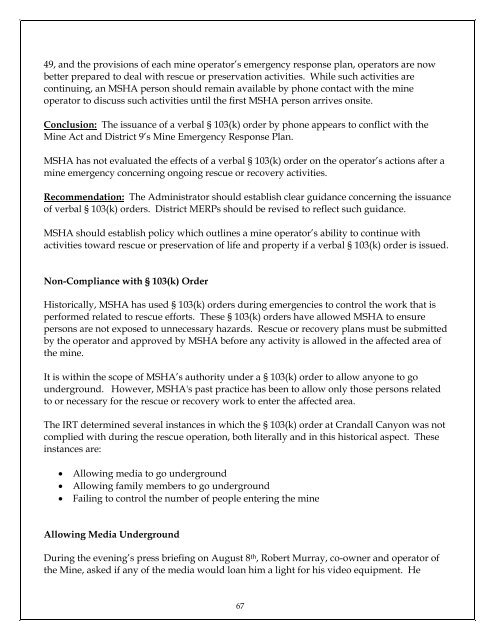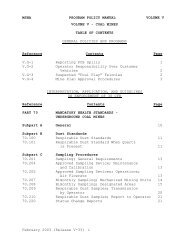Independent Review of MSHA's Actions at Crandall Canyon Mine
Independent Review of MSHA's Actions at Crandall Canyon Mine
Independent Review of MSHA's Actions at Crandall Canyon Mine
You also want an ePaper? Increase the reach of your titles
YUMPU automatically turns print PDFs into web optimized ePapers that Google loves.
49, and the provisions <strong>of</strong> each mine oper<strong>at</strong>or’s emergency response plan, oper<strong>at</strong>ors are now<br />
better prepared to deal with rescue or preserv<strong>at</strong>ion activities. While such activities are<br />
continuing, an MSHA person should remain available by phone contact with the mine<br />
oper<strong>at</strong>or to discuss such activities until the first MSHA person arrives onsite.<br />
Conclusion: The issuance <strong>of</strong> a verbal § 103(k) order by phone appears to conflict with the<br />
<strong>Mine</strong> Act and District 9’s <strong>Mine</strong> Emergency Response Plan.<br />
MSHA has not evalu<strong>at</strong>ed the effects <strong>of</strong> a verbal § 103(k) order on the oper<strong>at</strong>or’s actions after a<br />
mine emergency concerning ongoing rescue or recovery activities.<br />
Recommend<strong>at</strong>ion: The Administr<strong>at</strong>or should establish clear guidance concerning the issuance<br />
<strong>of</strong> verbal § 103(k) orders. District MERPs should be revised to reflect such guidance.<br />
MSHA should establish policy which outlines a mine oper<strong>at</strong>or’s ability to continue with<br />
activities toward rescue or preserv<strong>at</strong>ion <strong>of</strong> life and property if a verbal § 103(k) order is issued.<br />
Non-Compliance with § 103(k) Order<br />
Historically, MSHA has used § 103(k) orders during emergencies to control the work th<strong>at</strong> is<br />
performed rel<strong>at</strong>ed to rescue efforts. These § 103(k) orders have allowed MSHA to ensure<br />
persons are not exposed to unnecessary hazards. Rescue or recovery plans must be submitted<br />
by the oper<strong>at</strong>or and approved by MSHA before any activity is allowed in the affected area <strong>of</strong><br />
the mine.<br />
It is within the scope <strong>of</strong> MSHA’s authority under a § 103(k) order to allow anyone to go<br />
underground. However, <strong>MSHA's</strong> past practice has been to allow only those persons rel<strong>at</strong>ed<br />
to or necessary for the rescue or recovery work to enter the affected area.<br />
The IRT determined several instances in which the § 103(k) order <strong>at</strong> <strong>Crandall</strong> <strong>Canyon</strong> was not<br />
complied with during the rescue oper<strong>at</strong>ion, both literally and in this historical aspect. These<br />
instances are:<br />
• Allowing media to go underground<br />
• Allowing family members to go underground<br />
• Failing to control the number <strong>of</strong> people entering the mine<br />
Allowing Media Underground<br />
During the evening’s press briefing on August 8 th , Robert Murray, co-owner and oper<strong>at</strong>or <strong>of</strong><br />
the <strong>Mine</strong>, asked if any <strong>of</strong> the media would loan him a light for his video equipment. He<br />
67

















